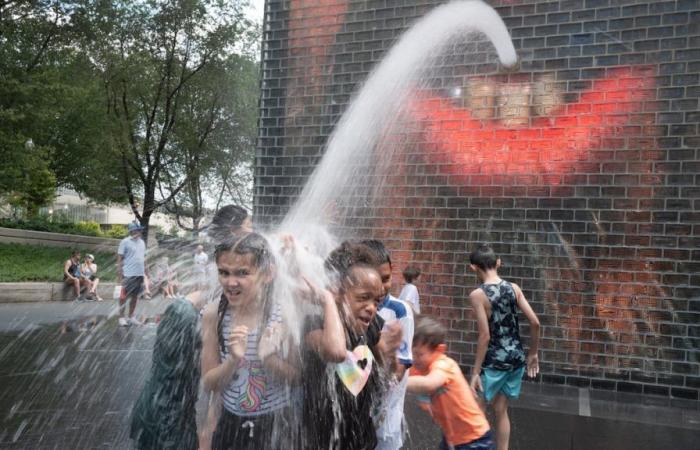
In New York, there is something that indicates the arrival of summer and with it, the suffocating heat that becomes more extreme every year: the fire hydrants open and the streets are transformed into small water parks. This is what happened this Tuesday with the arrival of the first heat wave of the season, which will punish the majority of the country until the weekend. Having hit the Midwest since last Monday, the weather has moved rapidly toward the northwest, where temperatures are expected to peak between Wednesday and Friday, with heat indices exceeding 100°F (37°F). .7 °C) in several locations.
This Tuesday, more than 77 million people, from Iowa to Maine, were under some level of alert due to what the National Weather Service has called a “dangerous and long-lasting” heat wave. In addition to the fact that the atmospheric phenomenon will bring the warmest temperatures so far this year, the federal agency highlighted that the heat will be even more dangerous due to its “persistence”, the little breeze there will be to combat it and the high levels of humidity. Hundreds of high temperature records are likely to be tied or broken throughout the week, with temperatures soaring as much as 25°F above average. There will be no relief at night either: temperatures will remain above 70°F (21°C).
The heat wave, which will move southeast late this week and early next week, was fueled by an intense heat dome (also known as a heat dome or heat wave, or heat dome in English) that has settled over the eastern half of the country. A heat dome occurs when a layer of warm air builds up near the Earth’s surface and becomes trapped by a layer of cooler air above it. The trapped air becomes increasingly hotter, creating a kind of oven over the earth. The high temperatures generated by this hot air mass can last for several days or weeks, causing dangerous heat waves like the one experienced this week.
In the United States, heat is the leading cause of weather-related deaths. In New York alone, approximately 350 people die prematurely each summer due to heat, according to a report published this Tuesday. Of those, most are heat-exacerbated deaths, meaning the heat aggravated an underlying illness. The city report adds that black New Yorkers are disproportionately affected by heat and are more likely to die from heat stress than others. The lack of air conditioning in the home is the main risk factor identified by researchers.
To deal with extreme heat, state and local authorities in the affected regions activated various emergency plans. Several states, including New York, Ohio, and Pennsylvania, enabled cooling centers, air-conditioned indoor facilities that can be used during the day. These include museums, libraries, community centers and shops. In New York, the Governor of the State, Kathy Hochul, also activated the National Guard, and the Mayor of the Big Apple, Eric Adams, announced that the Fire Department would be available to open fire hydrants and install spray caps, spray caps that when applied to the hydrant create a kind of water fountain in which it is common to see children playing and adults cooling off. Although it is illegal to open hydrants without notifying authorities, it is not uncommon to see someone do it on their own.
Consequences of scorching heat
Heat waves like the one the United States is experiencing this week are becoming more extreme and frequent due to climate change. In fact, last year, the country recorded the highest number of heat waves since 1936. The possible consequences of these atmospheric phenomena are several. For starters, extreme heat poses a serious health risk. Heat waves can cause serious symptoms, such as fainting, dizziness, headache, nausea, dehydration, or heat stroke. They can also aggravate chronic diseases such as cardiovascular or respiratory diseases. Older people, pregnant women, and newborns are among the groups most vulnerable to heat-related illnesses and deaths.
On the other hand, heat waves can increase pressure on water and energy, causing blackouts. They can also aggravate droughts and forest fires, which can have a negative impact on the agricultural sector. In fact, California and New Mexico are already battling wildfires. In the case of California, there are currently 10 active fires, including the Post Fire, the fiercest, which began on June 15. In New Mexico, Governor Michelle Lujan Grisham declared a state of emergency on Tuesday in some of the areas affected by the four active wildfires in the State.





